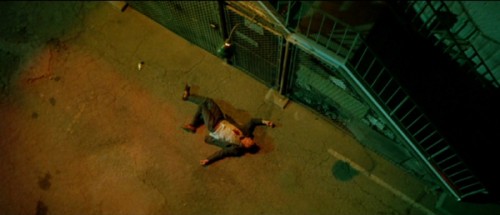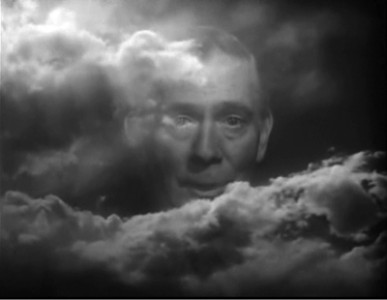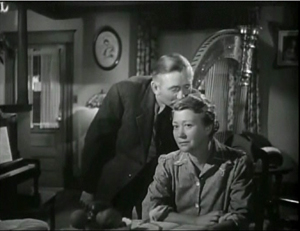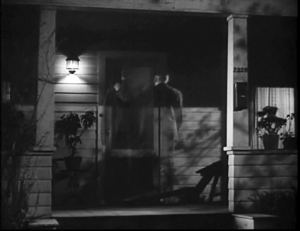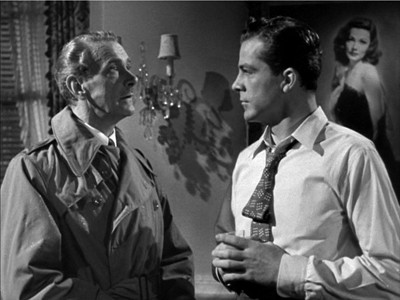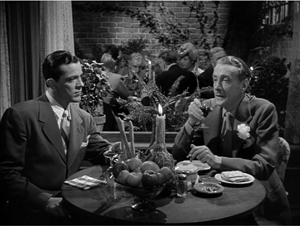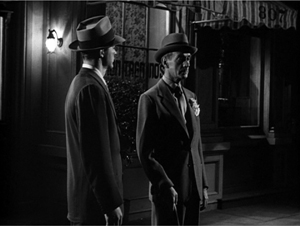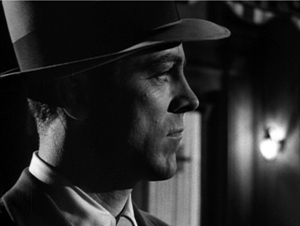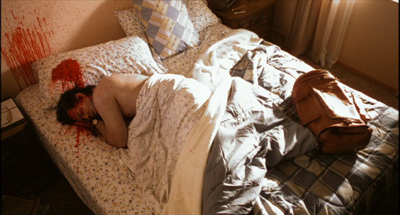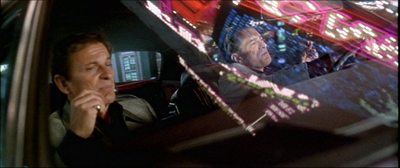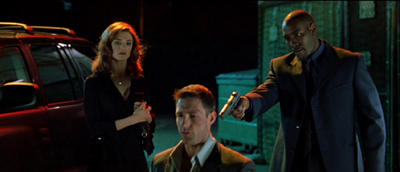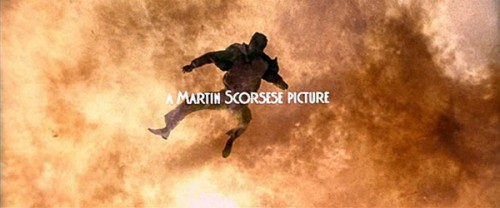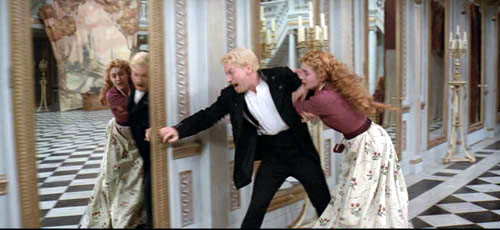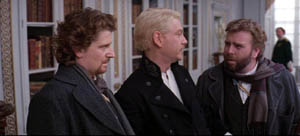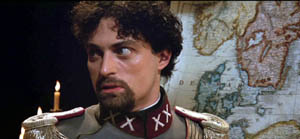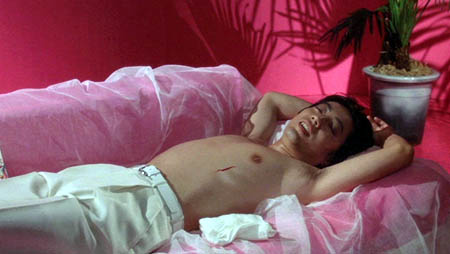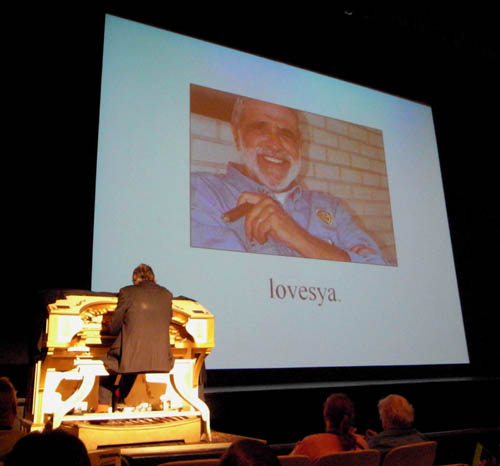Archive for the 'Directors: Schrader' Category
Dead man talking
Confidence (2003).
DB here:
“So I’m dead.”
At the start of Confidence we hear Jake Vig’s voice as we see him lying bloodied on a pavement. As the protagonist of a neo-noir, Jake recalls the classic start of Billy Wilder’s Sunset Boulevard (1950). There Joe Gillis (an echo of gigolo?), floating face-down in a swimming pool, begins to recount his stay as a kept man of faded film star Norma Desmond. That opening has become a touchstone for the grim fatalism of film noir, as well as a mark of daring screenwriting. The guy telling the story is dead! How cool is that?
Anybody interested in how films tell stories has to be interested in narrators, those figures—either mere voices or tangible characters—who recount, recall, or replay the story action. And anybody interested in Hollywood film knows that such narrators are hallmarks of a giddy period of cinematic innovation, as recognizably “1940s” as flashbacks, moody subjective sequences, and twisty plots. In that era we find narrators well outside that terrain known as noir. Romantic dramas, family sagas, comedies, Gothics, musicals, and other genres made ample use of voice-over commentary, and it didn’t always suggest a doom-laden atmosphere.
Still, dead narrators seem to be pushing things. They flout realism (How can a dead person tell anything?) and they raise problems of logic (To whom is this person speaking?). Is it a chatty corpse (Wilder originally wanted a morgue opening introducing Gillis) or an ethereal spirit divorced from the dead body?
Dead narrators turn up surprisingly often in the 1940s. During this period, as I’ve argued on this site and in the book I’m working on, many storytelling techniques we take for granted coalesced. There emerged a rough menu for handling them, and ambitious filmmakers played with several possibilities. That play didn’t stop in the Forties; we still have new versions of flashbacks, subjectivity, and the like. So let’s look at posthumous narrators in the Forties, with some glances at a trio of more recent efforts.
As a non-dead and highly reliable narrator, I must warn you of spoilers ahead.
Guiding spirits
The Human Comedy (1943).
Most simply, posthumous narration can be motivated as letters (Letter from an Unknown Woman) or diary entries (Thatcher’s journal in Citizen Kane). Similarly, Heaven Can Wait (1943) gives us a dead man explaining episodes from his life to an inquisitive official in the afterlife. The more flagrant cases, however, involve dead narrators who recount the entire film we see in voice-over, as in our prototype Sunset Boulevard. Knowing that the protagonist is dead at the start shifts our attention to how he or she will die.
Posthumous narrators go back a fair bit. In literature, Edgar Lee Masters’ Spoon River Anthology (1915) presents the ruminations of the town dead, in the manner of the cemetery climax of Our Town (1938 play, 1940 film). Wilfred Owen’s poetic monologue “Strange Meeting” (1918) presents soldiers reuniting in Hell, ending with the poignant line, “Let us sleep now….” Addie Bundren, the dead mother of Faulkner’s As I Lay Dying (1930), narrates portions of the novel from her coffin. In a pulpish pastiche of Faulkner, Kenneth Fearing’s mystery novel Dagger of the Mind (1941) includes a chapter narrated by a man who’s been murdered. Radio drama also included voices from the beyond. Examples include “Ghost Ship” (1940), with a victim recounting his own murder, and Norman Corwin’s “Untitled” (1944), which reveals the narrator to be a dead soldier.
In film, World War II brings forth the prospect of dead servicemen returning to tell their tales. “I am Matthew Macauley,” says a face superimposed over imagery of radiant clouds. “I have been dead for two years. But so much of me is still living that I know now that the end is only the beginning.” This is indeed a beginning, of The Human Comedy (1943). Having died in the war, Matthew will guide us back to his hometown and his household’s daily routines.
Matthew’s voice-over goes on to introduce his family members, including son Marcus on duty in the army. After a scene in which a spectral Matthew joins his wife at her work, his voice discreetly retires. It recurs only twice before he and his now-dead soldier son faintly enter to watch the family welcome their new member, Marcus’s pal Toby.
“You see, Marcus, the ending is only the beginning.” Matthew’s address to us has become piece of fatherly advice.
The dead narrator of The Human Comedy never intervenes in the action on earth, but an all-seeing intelligence exercises more authority in The Seventh Cross (1944). Seven prisoners escape from a concentration camp, and Ernst Wallau’s narration launches the film. During the escape sequence he rapidly introduces each of his comrades.
Fairly soon all but one are captured and executed on crosses planted in the prison yard. The first man to be crucified is Wallau, our narrator. After he is killed, his voice-over continues: “I was dead. I could see.”
Wallau’s commentary chiefly follows his friend George Heisler, who manages to elude the Gestapo while the other escapees are found and killed. Wallau’s narration continues through the film, chronicling not only the fates of the other men but probing Heisler’s state of mind. Wallau tells us what Heisler is thinking, guides us into his memory, notes things that Heisler has forgotten, and even informs us what other characters will do in the future. Confronted with this numb, almost mute character, we need the continual commentary of Wallau to give access to his inner life.
Wallau is that rare voice-over narrator who flaunts his omniscience. Being dead, he has total access to our world and can witness anything happening there. Despite Wallau’s godlike power, in good Hollywood tradition his narration attaches itself chiefly to Heisler. But here that restriction reflects simply Wallau’s foreknowledge, signaled at the start, that only Heisler will survive. The question becomes: How?
The answer comes through Wallau’s goading Heisler to find faith in others. At the start, Heisler is close to despair, and his flight stems from sheer instinctual survival. At the film’s midpoint, all his comrades have been killed, and Wallau’s long-term escape plan has failed. Heisler can’t any longer mechanically follow his mentor’s instructions. He must forge a new goal, seize the initiative, and learn to trust people. He must learn what Wallau told him from the start: there remain traces of humanity in Germany.
As Heisler’s hopes grow and his network of allies expands, Wallau’s prodding voice-over subsides. It reappears near the end, at the moment Heisler realizes how much he owes others. Heisler speaks of his debts, and Wallau murmurs in antiphony the names of those who have helped him, including some Heisler has never met.
Now that Heisler has joined the struggle with full commitment, Wallau can vanish. “Goodbye, George Heisler. I can leave you now.”
Ghostly narrators like Wallau and Matthew Macauley call to mind the nosy angels and spooks of so many 40s films. Those have their counterparts in radio dramas like “Good Ghost” (1948) and the parodic mystery novel Dead to the World (1947), with a dead detective narrating his efforts to solve a case.
As usual, a lot depends on timing of information. If we learn that the narrator is dead at the start, as in the films just mentioned and in Scared to Death (1947), a certain amount of the action can seem foreordained. Alternatively, there can be a surprise. Radio plays, it seems, tended to reveal their dead narrators as a twist ending. With less fanfare, a film can simply seem to forget the opening commentary. The Gangster (1947) is initially narrated, without a frame situation, by the crooked protagonist. As a result, we expect him to survive. Yet he dies in the course of the action. The filmmakers faced a problem: To return to the narration at the end or not? To revive his voice-over might suggest that he endures in some supernatural realm. Instead, an impersonal external voice takes over to balance the opening.
With the convention of the dead narrator in place, a film could flirt with the possibility that the initial voice we hear has no living source. The opening credits of Woman in Hiding (1950) strongly suggest that a betrayed wife, racing down a hillside at night before crashing over an embankment into a river, has been killed. Her commentary rises up during a scene of the police dragging the river, and she seems to be mocking her husband from beyond the grave.
Is this a female variant of Joe Gillis’ voice-over? Watch the whole movie to find out.
In the same year as Woman in Hiding, Sunset Boulevard gave us another voice from the Beyond. If the film’s technique seems less original coming after a string of dead narrators, at least it can be credited with making the narrator the protagonist (unlike The Human Comedy and The Seventh Cross) and for using the device in a full-blown A picture (unlike Scared to Death and The Gangster).
In sum, the dead-narrator technique became a schema, a pattern which filmmakers could simply copy, as in Scared to Death, or tweak, as in the apparently dead narrator of Woman in Hiding. Wilder offered his own variant on the schema. We tend to remember his as the prime example, maybe even as the first one. But it often happens in the 1940s that the originality of a noteworthy film stems from a revision of a schema that was already in circulation, not only in film but in other media.
The weekend Laura died
Occasionally, the variety of options at the period sets up more dissonant relations. Laura (1944) is probably the most famous example.
Vera Caspary’s original book is divided principally into first-person blocks recounted by bon vivant Waldo Lydecker, detective Mark McPherson, and magazine editor Laura Hunt. Early versions of the screenplay attempted to capture multiple-viewpoint narration through flashbacks and voice-overs. What happened to this structure, however, reveals a process we’ll encounter elsewhere: fiddling with the film in post-production yielded some startling, perhaps unintended novelties.
Laura Hunt has apparently been murdered by a shotgun blast to the face. When the film starts, McPherson is calling on her mentor Waldo Lydecker, an effete columnist and radio commentator. McPherson lets Waldo accompany him on his inquiries before the two retire for a dinner at the restaurant Laura loved. There, via flashbacks and voice-overs, Lydecker recounts Laura’s rise to prominence. (In a scene cut from the final film, there’s an indication that Waldo’s tale is partly false—an early instance of a lying flashback.) The other characters’ flashbacks and voice-overs were abandoned in production, so the rest of the film is rendered objectively.
We later learn that the original victim was not Laura, which makes Laura either a new suspect or a target for the killer’s second try. At the climax, it’s revealed that Waldo is the culprit; he concealed the gun in an antique clock that he had given Laura. While his pre-recorded program is broadcast, he returns to her apartment and tries to kill her. Laura eludes him and as he wildly fires his gun, he is shot by McPherson’s team.
What makes the finale curious is the film’s framing device. The first scene starts with Waldo’s voice-over: “I shall never forget the weekend Laura died.”
This appears to cast the entire film as a flashback, starting with McPherson’s visit to Waldo. Within that flashback to the weekend, we have further flashbacks–that is, Waldo’s dinner-table explanations to McPherson. Such Russian-doll embedding is found elsewhere during the 1940s. At the end of the evening, when Waldo leaves, the camera lingers on McPherson and we become attached to him for nearly all that follows.
In screenplay drafts, this last shot would have initiated Mark’s voice-over narration, which would constitute a chunk parallel to Waldo’s. This is further evidence that Waldo’s string of flashbacks, including his opening voice-over, functions to write finis to “his” section of the film. But in the finished film, without McPherson’s voice-over block, Waldo’s initial voice-over hangs there, apparently framing the whole film. It would have been easy simply to cut that commentary and retain the opening camera movement revealing McPherson browsing among Waldo’s treasures, perhaps with some more nondiegetic music. Then Waldo’s offscreen admonition would bring in his voice for the first time. After this, Waldo’s later flashbacks and his voice-over narration would become neatly nested and perfectly conventional.
Clearly, decision-makers wanted to retain Waldo’s ripe commentary to open the film; it has expository value, and it introduces a very intriguing character. But we don’t hear that enveloping voice again, so for the rest of the film we might take Waldo’s remarks as akin to those that open Rebecca (1940) or Flamingo Road (1949). In these films and many others, a reminiscing character voice introduces the story action from an unspecified point in time and space. And the plot’s shift to McPherson’s activities seems to suggest that the whole opening stretch, including Waldo’s initial recounting, should be taken as a unit, “his” section of the film. So when Waldo is shot down and starts to die, we might have a situation like that of The Gangster, where the narrator is killed in the course of the action he introduced, and the film forgets what started it all.
Instead, Laura takes the option that The Gangster avoided: it brings back the dead man’s voice. After Waldo collapses, there’s a cut to McPherson and Laura leaving the frame. As the camera moves in on the shattered clock face, we hear, “Goodbye, Laura. Goodbye, my love.”
The line might be taken as Waldo’s dying words spoken offscreen, except that the line is miked far more closely than his speech earlier in the scene, when he’s actually closer to he camera. In its acoustic texture, this unsituated sign-off formally balances the unsituated opening. But it also raises the possibility that the dead Waldo has launched the whole story and now bids Laura farewell from that realm wherein defunct narrators dwell.
The opening does hint that something otherworldly is going on. A tart, suave voice wells up from sheer darkness, perhaps a noir equivalent to the sunny eternity from which Matthew Macauley speaks in The Human Comedy. Yet for a dead narrator, Waldo is either ill-informed or misleading. He speaks of “the weekend Laura died.” But if he lived through the events of the film, he knows that she did not die. Of course, his fib helps the film mislead us; the first half presupposes that Laura was the victim. If we remember that an unused scene was going to reveal that his flashback tales to McPherson contained lies, we may conclude that Waldo is as unreliable in death as he was in life.
Some of these inconsistencies apparently spring from late decisions in production. The original ending, as scripted and shot, lets Waldo survive. As he’s led off, he says, “Thank you for everything, my dear. . . You’re all I’ll be thinking of—till Time stands still—for me. Goodbye, Laura.” The speech is heard offscreen as the camera pans and holds on the clock.
Fox production head Darryl F. Zanuck was dissatisfied with many aspects of this conclusion and so a new version was filmed. In that version, Waldo is shot and dying. We see him speak the same lines, and only then does the camera pan to the clock. The release version, with Waldo’s simpler, closely miked farewell over the shot of the clock, was evidently decided on still later.
For what it’s worth, both the original shooting script and the revision distinguish between lines marked as “WALDO (narrating)” and “WALDO’s voice” for offscreen delivery. In neither version are Waldo’s dying lines marked as “narrating.” And in neither do we get an indication of the final camera movement that lets Laura and McPherson leave the shot in order to target the shattered clock face. Yet we do have a sonic texture in the last lines that is closer to a narrator’s voice.
In sum, while presenting a haunting conclusion—the clock was Waldo’s gift to Laura, and the shattered face recalls his first victim—the soundtrack firmly reminds us of the opening. Do we have a dead narrator? Some cues are there, but they’re sketchier than those in other films of the era. (For one thing, in those films, the narrator tells us he or she is dead.)
The unexplained return of Waldo’s voice, now gentle, has a surprising poignancy. Because of its loose ends, the final moments become more evocative, and more poetically enticing, than the tidy, explicit wrapup of Sunset Boulevard. In such ways, Laura’s final moments provide an eccentric revision of the dead-narrator schema. The result may have encouraged filmmakers who followed to risk inconsistency for the sake of powerful immediate effects.
In an earlier entry, I traced how studio pressures made the narration of Preston Sturges’ The Great Moment oddly off-balance. Evidently something like this happened with Laura. In the pressure to get a film finished and out the door, to retain striking bits that may ultimately not make sense when put together, Hollywood filmmakers can innovate by accident.
Dead men tell no tales
Auto Focus (2002).
Once the dead-narrator schema was available, Forties filmmakers were able to tweak it in various ways. And the changes didn’t end then. To see how the same process of schema and revision has continued, consider three much more recent examples.
Paul Schrader’s Auto Focus is a straightforward case. Bob Crane’s voice-over appears early in the film, though not at the very start, and recurs six times before the final scene. The brief comments punctuate Crane’s career decline and his descent into sex addiction. As happens with The Seventh Cross and other films using voice-over narrators, the second half employs the device less intensively than does the first. It’s as if in a film’s Development section we’re expected to be absorbed enough in the action not to need explanation, and we’re sufficiently primed to know what the important issues are.
When Crane’s head is bashed in by his companion in sexual buccaneering, we have a case comparable to The Gangster: the narrator doesn’t survive. Crane’s voice has been silent for 28 minutes, so we might assume that we’ve lost his voice-over. But it returns over his bloody body, recounting in an offhand way the aftermath of his death. His voice remains as perky as it has been early in the film, in both his commentary and his explanations to his wives. “I’m a normal guy,” he has insisted, and his bland wrapup shows him insouciantly unaware of the implications of living and dying as he did. He can’t condemn his killer. “He was a cool guy in his way. . . . Men gotta have fun.”
Martin Scorsese’s Casino (1995) reworks the dead-narrator schema in more complicated ways, in the process borrowing other 40s conventions. During that period, multiple-narrator films became quite common. Again we have a prototype—Citizen Kane (1941)—but again it wasn’t alone. Trial films featuring flashbacks that dramatize testimony had become fairly common in the 1930s, and a couple of detective films (e.g., Affairs of a Gentleman, 1934; Thru Different Eyes, 1942) used flashbacks to present different witnesses’ versions of events. It would become a staple of crime films like The Killers (1946). Julien Duvivier’s Lydia (1941) transposed the multiple-narrator technique to the melodrama, while The Affairs of Susan (1945) applied it to romantic comedy. Mankiewicz, who seems quite obsessed with the strategy, deployed it in A Letter to Three Wives (1949), All about Eve (1950), and The Barefoot Contessa (1954).
A less common 1940s convention is the replay—the passage that repeats a scene, usually in flashback and usually including information not shown in the first pass. The most famous example is Mildred Pierce (1945), which I’ve fretted at for years (in this entry and this video). We can find less crucial replays in, again, Kane (Susan’s opera debut) and in more obscure films like Beyond Glory (1948).
Casino draws on the replay and the multiple-narrator format and blends them with the dead-narrator one. The film innovates in a couple of striking ways. First, in 1940s multiple-narrator films, the individual narrations are presented in blocks; a solid chunk from one voice, another from another. True, we see some leakage in All about Eve, but basically the narrators’ tales are kept distinct. Scorsese and Nicholas Pileggi’s script for Casino hops between two principal narrators, Ace Rothstein (Robert de Niro) and Nicky Santoro (Joe Pesci).
Ace and Nicky’s voice-overs are mostly very brief, tagging a cascade of episodes tracing each man’s rise in Vegas, with equally fleeting flashbacks to their origins. The first twenty minutes toggles ten times between the two men’s clipped commentaries. This stretch constitutes a sort of training session, preparing us for the rapid switches in viewpoint that will dominate the film. Again, though, the voice-overs will subside for stretches in the middle, when the scenes become more fully developed. As a momentary, almost twitchy variant we get one extra voice-over—that of a go-between who, in a freeze frame, decides not to tell the mob boss about Nicky’s betrayal of Ace. Significantly, the film’s third major character, Ginger McKenna (Sharon Stone), is allotted no voice-overs.
So Scorsese and Pileggi have fractured the 1940s voice-over schema. But the to-and-fro commentaries I’ve mentioned come after an opening sequence that seems to announce that one of these wise guys is already dead. The first scene shows Ace being blasted out of his car by a bomb. A sprawling body, as if ejected from the explosion, floats through the opening credits. And Ace’s next voice-over launches the film’s cascade of flashbacks by saying they come from the period “before I got myself blown up.” We seem to be in the full-fledged presence of a dead narrator.
We are, but it’s not Ace. At the film’s climax, it will be Nicky who dies at the hands of his own crew. In replays of the car explosion, it’s revealed that Ace actually survived the blast. By 1995 Scorsese and Pileggi could revise the 1940s schema by splitting the narrators and misdirecting our expectations: the apparently living narrator is the one who will die.
What, finally, of Confidence? Jake’s admission that he’s dead fits snugly into the tradition we’re considering, especially since it’s a voice-over initiating a flashback. That flashback takes us to the moments before his execution at the hand of the triggerman Travis.
In those moments Jake explains how his team of grifters accidentally took money belonging to a gang boss and how they proposed to repay him with an even bigger con job. That central story action, itself peppered with backstory exposition, is interrupted by returns to the opening execution situation. Jake’s first voice-over, apparently addressed to us, is differentiated by sonic texture from his explanations to Travis, but when his voice leads us to the past, it has the same degree of auditory presence. In effect, it’s the same confusion of narrating levels that’s promoted in the first long stretch of Laura.
At the climax of Confidence, we see Jake shot not by Travis but by the moll Lily. Travis flees, and so does she. Now we’re back to the opening situation, and a replay of Jake’s opening line, “So, I’m dead.” He seems to sign off. But now more flashbacks reveal that Jake and Lily have staged her gunplay and that the whole scheme has been a very long con. The team reunites and goes off with their millions. Confidence has appealed to our knowledge of the dead-narrator convention to fake us out: the story action won’t end with his death because he’s stage-managed it.
Jake lied about being dead. But so did Ace when he referred to being “blown up.” So did Waldo, maybe. And so do those films that don’t signal that the protagonist has fallen into a dream or a reverie. Actually, narratives are incorrigibly deceptive and full of secrets. You can’t even trust dead guys.
As ever, we’re reminded that modern filmmakers inherit a vast tradition of narrative schemas. Those can be reiterated or revised in unpredictable ways. The tradition is kept alive and engaging, as long as novelty is balanced with familiarity, innovation with redundancy. (Let the narrators explain, throw in some replays,) The way Hollywoood tells it is always indebted to the ways Hollywood told it.
For more examples of dead narrators see the Wikipedia entry and TV Tropes. Long as they are, these lists tilt heavily toward contemporary examples, where posthumous narration seems very common. One reason I posted this entry was to acknowledge older instances of this convention.
Ray Collins was a well-known radio voice as well as a Welles Mercury player. As both Matthew Macauley and Wallau, he seems to have been the go-to man for reliable supernatural voice-over. He had a long Hollywood career, but most baby boomers remember him best as Lieutenant Tragg in the Perry Mason TV show.
I’m indebted to Neil Verma for information about the posthumous narrator in radio plays. Neil also mentions “The Hitch-Hiker” (1942), and these episodes of Quiet, Please: “Inquest” (1947), “In Memory of Bernadine” (1947), “Anonymous” (1948), and “I Always Marry Juliet” (1948). (Listen to any of these here.) Filmgoers probably encountered more dead narrators on radio than on film. Neil’s book, Theater of the Mind, is an excellent account of 1930s and 1940s radio narrative.
The shooting script of Laura is available here. The revised ending is included as well. See also the detailed comparison of the two endings by Despina Veneti at Preminger Noir. The first analysis of the different versions was, I believe, carried out by Jacques Lourcelles in “Laura: Scénario d’un scenario,” L’Avant-scène du cinéma no 211/212 (July-September 1978), 5-11. This publication includes a French-language transcript of the film as we have it, along with cut portions. A detailed account of Laura’s production is provided by Chris Fujiwara in The World and Its Double: The Life and Work of Otto Preminger (Faber and Faber, 2008), pp. 36-48. I’m grateful to Jeff Smith for his advice about the sonic texture of Waldo’s voice-over.
The narrational issues raised by Laura go beyond the deceased Waldo’s voice. In the film’s most famous scene, McPherson is becoming obsessed with the dead Laura and, after drinking heavily, he falls asleep in her apartment. The camera tracks slowly in on him as he drops off. There’s the noise of a door from offscreen, and Laura walks in. McPherson is astonished. Laura, released the same week as The Woman in the Window, might seem to be hinting that Laura has been revived in McPherson’s dream.
Kristin has traced the numerous dialogue motifs that reinforce this possibility. Yet most films of the 1940s mark a dream sequence very explicitly (e.g., wavy superimposed lines, dissonant music) or at the least with a dissolve and a close-up or track-in reinforcing the shift to subjectivity. Laura provides only two cues, the sleeping character and the track-in. But as Kristin indicates, these and other factors keep the dream option a possibility for a first-time viewer. See “Closure within a Dream? Point of View in Laura,” Breaking the Glass Armor: Neoformalist Film Analysis (Princeton University Press, 1988), 162-194. Kristin’s essay also offers a comprehensive discussion of the shifts in Waldo’s narration.
The presence of dead narrators would seem to pose a problem for those scholars who believe that in a movie every narrator must have a narratee on the same logical level. For these theorists, film narrators are part of a symmetrical system of communication among personified entities. Those entities are either embodied in the text (McPherson is Waldo’s narratee in the restaurant) or implicit in the very logic of narrative itself. No narrator without a narratee! According to this line of argument, there must be a narratee as dead as Waldo listening to his opening voice-over, but being very, very quiet.
In contrast, I’ve argued that films, and possibly all narratives, are freewheeling and illogical in their use of markers of communication. Films may mimic only parts of a communicative circuit in order to achieve specific effects. In provoking experiences in readers, films seem to me to rely on psychology, not ontology. I float this argument in this chapter of Poetics of Cinema. See also this blog entry.
Earlier entries have touches on the schema-and-revision dynamic of style and story in Hollywood. See for examples my discussion of 1913 films, a consideration of 1940s style, some remarks on walk and talk, a piece on high-school lipdubs, a discussion of replays, and the entry on Gone Girl. Searching “schema” will bring up more. A roundup of entries on peculiar 1940s narratives is here. I analyze narration in All about Eve here. For more on the debt of modern film to 1940s innovations, see The Way Hollywood Tells It.
Casino.
The show goes on
DB here:
Kristin and I had hoped to blog directly from this year’s edition of Ebertfest (formerly Roger Ebert’s Festival of Overlooked and Forgotten Films), but our blogging software failed us. We could post text but no pictures, and where’s the fun in that? Fortunately, the event was widely covered. The schedule, with very full film notes, is here. You can get a sense of what was happening by checking Jim Emerson at scanners and Peter Sobczynski at Hollywood Bitchslap and Kim Voynar at Cinematical and Lisa Rosman at A Broad View and P. L Kerpius at Scarlett Cinema and Andrew Wells at A Penny in the Well and many others. There is some coverage at the News Gazette, although the most informative stories from the paper aren’t on the net. Then there’s Roger’s own blog, Ebertfest in Exile, which in one entry goes off on an unexpected trajectory….toward Joe vs. the Volcano.
Now that we can again illustrate our entry, we offer you an ex post facto blog, like last year’s, which makes up in bulk for its tardiness. I hope to follow soon with a picture gallery.
This year’s Ebertfest lacked an essential ingredient: Roger Ebert. But Chaz Ebert took over hosting duties superbly, aided by the terrific organizational skills of Nate Kohn and Mary Susan Britt. At every screening, one person or another paid tribute to Roger’s gifts to film culture—his writing, of course, but also his tireless championing of deserving movies that should be brought to wider audiences.
The format of Ebertfest offers something for everyone. Traditionally, the opening night is an older film screened in classic 70mm, a format that’s almost vanished. Past years have included shows of Lawrence of Arabia, Play Time, and My Fair Lady. 70mm looks gorgeous on the vast screen of the Virginia Theatre. This year the film was Kenneth Branagh’s Hamlet, at four hours the most complete version of the play ever put on film. It looked grand.
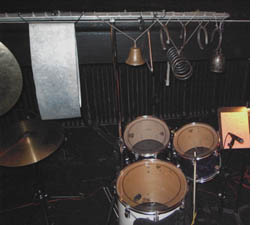 Another slot is reserved for a silent movie, often accompanied by the Alloy Orchestra. (Part of their armory, including bells, springs, and a thunderstrip, can be found on the left.) Having programmed The Black Pirate, The General, and The Eagle in earlier years, Roger picked von Sternberg’s sumptuous Underworld (1927), which Kristin introduced and led a discussion about. The Alloy boys’ scores are getting more nuanced by the year, and this one did as much justice to von Sternberg’s quiet passages as to the gunplay.
Another slot is reserved for a silent movie, often accompanied by the Alloy Orchestra. (Part of their armory, including bells, springs, and a thunderstrip, can be found on the left.) Having programmed The Black Pirate, The General, and The Eagle in earlier years, Roger picked von Sternberg’s sumptuous Underworld (1927), which Kristin introduced and led a discussion about. The Alloy boys’ scores are getting more nuanced by the year, and this one did as much justice to von Sternberg’s quiet passages as to the gunplay.
Yet another Ebertfest mainstay is a children’s show on Saturday morning, and last year’s wonderful Holes was followed by an unexpected pick—Ang Lee’s Hulk, with the director in attendance. The place was packed, Lee was his charming self, a trio serenaded him, and the audience left well-pleased.
Prime spots are reserved for less-known films, with an emphasis on independent and personal cinema. We saw Tom DiCillo’s Delirious, Sally Potter’s Yes, Joe Greco’s Canvas, and Jeff Nichols’ Shotgun Stories. A highlight for me was Eran Kolirin’s The Band’s Visit, which I’d missed elsewhere. This unassuming, warm, funny movie recalled Tati and 1960s Czech films like Intimate Lighting. Then there was The Cell by Tarsim Singh at a late-night screening, with John Turturro’s Romance and Cigarettes to wrap things up on Sunday. For kaleidoscopic commentary on all these, see the above-mentioned weblogs.
Princely contradictions
I hadn’t seen Hamlet in 70mm in its initial 1996-1997 run, and at first the idea of taking this fairly intimate piece to a wide-film format seemed counterintuitive. But on the Virginia screen the film lost none of the play’s intensity and it gained a welcome monumentality. The central set, the Danish throne room as a gigantic hall of mirrors flanked by a warren of corridors and fissured by secret passageways, is made for the wide image.
Scale of time also matters. By playing the full version, Branagh can give full weight to the father/ son parallels that riddle the play. If Olivier’s Hamlet was about a son’s love for his mother, Branagh makes the play about the strife between fathers and sons, with women caught in the middle. Hamlet Sr./ Hamlet Jr., Claudius/ Hamlet, Jr., Polonius/ Laertes, old Norway/ Fortinbras, and even the Player’s speech about the murder of Priam: the parallels are in Shakespeare’s text but played out at proper length they snap into sharp relief. Once Laertes is off to Paris, Polonius makes sure he’s spied on, just as Claudius orders Rosenkrantz and Guildenstern to watch Hamlet. In his turn, Hamlet assigns Horatio surveillance duty during the play-within-a-play (a piece of action nicely caught in the opera glasses that Branagh’s choice of period allows). Branagh’s decision to emphasize the military politics around Fortinbras’ march into Denmark helps justify the 70mm format and his decision to set the action in late nineteenth-century Europe; it also allows him to expand, through crosscutting set up early in the movie, the plot of another son at odds with his father.
Sex is important in this game. Branagh presents flashbacks to Hamlet and Ophelia in bed together, accentuating the prince’s later indifference and motivating her despair at his rejection. Not that the fathers don’t clock some mattress time too. Claudius the urbane politician becomes an infatuated newlywed, and Derek Jacobi gives to my mind a definitive performance. Even Polonius, usually treated as a pompous ass, smokes worldly little cigars and has a drab tucked into his bed, so that his advice to Laertes and Ophelia about proper conduct becomes not only patronizing but hypocritical.
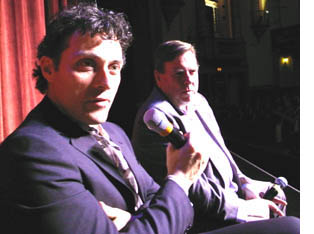 During the Q & A, Timothy Spall and Rufus Sewall emphasized something that Branagh explains on the DVD set: the need to create ensemble performances out of footage shot at different times. Sewall (a dark and scary Fortinbras) was filmed in a few days, before full-blown production, with his bits cut into the film at intervals. Robin Williams, as Osric, was also filmed out of continuity; there are scarcely any shots of him in the same frame as other players.
During the Q & A, Timothy Spall and Rufus Sewall emphasized something that Branagh explains on the DVD set: the need to create ensemble performances out of footage shot at different times. Sewall (a dark and scary Fortinbras) was filmed in a few days, before full-blown production, with his bits cut into the film at intervals. Robin Williams, as Osric, was also filmed out of continuity; there are scarcely any shots of him in the same frame as other players.
Spall, a temporizing Rosenkrantz, was present for much more of the filming and was eloquent in explaining how shooting in long, wheeling takes demanded great precision from the actors—hitting marks, using body language, and timing speeches carefully.
Branagh put the bulky 70mm camera on a dolly, then reinforced the studio floors so that no tracks or boards were necessary; the camera could glide anywhere. “Walk and talk” technique, which I’ve blogged about before, comes home to roost in a Shakespeare film; Branagh wanted continuous shots so that the audiences could follow the flow of the speeches, and it works very well.
In fact, Branagh’s editing varies in a patterned way across the play. Acts I and III are briskly cut, averaging about 5 seconds per shot. Acts II and IV rely on much longer takes, typified by the tracking-shot arabesques, and they average 10-11 seconds per shot. And Act V? Here, as you might expect, Branagh pushes the pace to suit the converging plotlines and the burst of poisonings at the climax: the average shot runs about 3 seconds. This seesawing rhythm helps sustain viewer interest across four hours, and it shows an unusually geometrical approach to a movie’s overall architecture.
In his program review, Roger points out that the play remains deeply mysterious, even in a production as lucid and buoyant as Branagh’s. Hamlet is of course one of the most fascinatingly inconsistent characters in literature. I’ve read the play probably a dozen times and seen many film versions of it, and I’m inclined to think that in Hamlet Shakespeare is experimenting with how indeterminate a character can be and still be intelligible to us. It’s not that he’s indecisive; we have to decide what he truly is, and Shakespeare makes our task very hard.
All the other characters in the play are complicated but consistent. Only Hamlet seems to reinvent himself at every entrance. He tells us that he will put on an “antic disposition,” but before he’s gotten very far with his fake madness, he tells Rosenkrantz and Guildenstern of his strategy, knowing that they are likely to report it to Claudius. This has the effect of letting Hamlet behave any way he wants, sincere or duplicitous, calculating or mad. When he’s around others, he’s always “on,” and this makes his true nature and purposes difficult to divine.
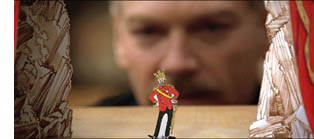 I liked Branagh’s idea of having Hamlet consulting a book on demonology, for in a revenge tragedy the protagonist has to be sure that the aggrieved spirit urging revenge isn’t a demon in disguise. More generally, the Victorian milieu lets Branagh give us a truly bookish Hamlet, one who retreats to his stuffed library when overcome by the strife unfolding in the vast throne room. At the same time, that library contains players’ masks and a curious miniature theatre that Hamlet toys with thoughtfully. He lives among books, but also among images of pretense and deceit.
I liked Branagh’s idea of having Hamlet consulting a book on demonology, for in a revenge tragedy the protagonist has to be sure that the aggrieved spirit urging revenge isn’t a demon in disguise. More generally, the Victorian milieu lets Branagh give us a truly bookish Hamlet, one who retreats to his stuffed library when overcome by the strife unfolding in the vast throne room. At the same time, that library contains players’ masks and a curious miniature theatre that Hamlet toys with thoughtfully. He lives among books, but also among images of pretense and deceit.
The questions tease you right to the end. Hamlet finds Laertes’ plunge into Ophelia’s grave overdramatic, but he goes on to declare that he himself loved her with the strength of forty brothers. Before the climactic duel, Hamlet apologizes to Laertes (“I have shot my arrow o’er the house/ And hurt my brother”), but it seems almost bad faith, given all the misery he has helped cause. Is this a morally obtuse sincerity, or another masquerade? It’s this Hamlet, reliably unpredictable, that Branagh’s manic-depressive performance brings home so forcefully.
The unwitting wisdom of the suits
It’s common to say now that the 1970s was the last great era in American cinema, followed by the degradations of the blockbuster 80s, but that remains little more than PR. Putting aside the “revolution” of the 1970s, which seems to me overrated, I’ll just offer the opinion that the 1980s brought us many worthy films, some of them quite daring. For example, one of the sweetest “little movies” of the era is Bill Forsyth’s Local Hero (1983).
It’s a comedy, at once dry and warm, about an oil executive sent to buy a small Scottish town and beachfront in preparation for the installation of a pumping rig and refinery. Forsyth’s script reverses the cliché. The townsfolk, far from clinging to their beloved tradition, are in fact anxious to sell and look forward to being rich. The young executive, Mac, doesn’t try to drive a hard bargain but settles into the rhythm of a life different from that he has known. His boss, a passionate amateur astronomer, surprises everyone with his final decision about the deal. You might call Local Hero one of the first films about the clash of global capitalism and community values, but though that’s accurate, the schematic formula doesn’t capture the understated humor and humanity of Forsyth’s treatment.
Forsyth is at Ebertfest for a screening of his no less brilliant Housekeeping; see Jim Emerson’s eloquent and poised review here. But I wanted to ask about Local Hero. The Scottish village is rendered with the affectionate good humor we find in Ealing comedies, and Forsyth mentioned that after he’d made the film he discovered an Alexander Mackendrick movie, The Maggie (1955), that prefigured his. For me, there were echoes of Jacques Tati in the long-shots and sound gags, and Forsyth confirmed that one of the formative films in his youth was M. Hulot’s Holiday, screened by an indulgent school head.
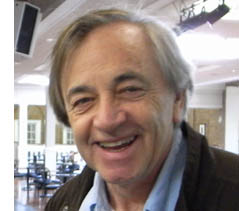 Forsyth talked about certain choices he made. The Mark Knopfler score, bringing together Scottish tunes and a Texas twang, helped open out the film in a way that a more conventional lyrical score would not. Forsythe talked as well about the final shot, one of the most satisfying I’ve ever seen. The original cut ended with Mac returning to his Houston apartment and staring out at the dark urban landscape—beautiful in its own way, but very different from the majesty of the Scottish shore. There the original film ended, but the Warners executives, although liking the film, wanted a more upbeat ending. Couldn’t the hero go back to Scotland and find happiness, you know, like in Brigadoon? They even offered money for a reshoot to provide a happy wrapup. Forsyth didn’t want that, of course, but he had less than a day to find an ending.
Forsyth talked about certain choices he made. The Mark Knopfler score, bringing together Scottish tunes and a Texas twang, helped open out the film in a way that a more conventional lyrical score would not. Forsythe talked as well about the final shot, one of the most satisfying I’ve ever seen. The original cut ended with Mac returning to his Houston apartment and staring out at the dark urban landscape—beautiful in its own way, but very different from the majesty of the Scottish shore. There the original film ended, but the Warners executives, although liking the film, wanted a more upbeat ending. Couldn’t the hero go back to Scotland and find happiness, you know, like in Brigadoon? They even offered money for a reshoot to provide a happy wrapup. Forsyth didn’t want that, of course, but he had less than a day to find an ending.
The movie makes a running gag of the red phone booth through which Mac communicates with Houston. Forsyth remembered that he had a tail-end of a long shot of the town, with the booth standing out sharply. He had just enough footage for a fairly lengthy shot. So he decided to end the film with that image, and he simply added the sound of the phone ringing.
With this ending, the audience gets to be smart and hopeful. We realize that our displaced local hero is phoning the town he loves, and perhaps he will announce his return. This final grace note provides a lilt that the grim ending would not. Sometimes, you want to thank the suits—not for their bloody-mindedness, but for the occasions when their formulaic demands give the filmmaker a chance to rediscover fresh and felicitous possibilities in the material.
Salvation through self-punishment
Another outstanding film of the 1980s is Paul Schrader’s Mishima: A Life in Four Chapters (1985), which he brought to Ebertfest in a sparkling print. Schrader is one of two American film critics who became major directors (Peter Bogdanovich is the other), and there’s little doubt that he’s the most cerebral and theoretically inclined of that group known as the Movie Brats. Even if he hadn’t written milestone screenplays (Taxi Driver, Raging Bull) and made provocative films (Blue Collar, Hard Core, Affliction), he would be remembered for his critical writing. A trailblazing essay on Joseph H. Lewis, “Notes on Film Noir,” the essay on the yakuza film, and the book Transcendental Style in Film (1972) made Schrader a distinctive voice in American film culture. Fortunately you can now read his entire oeuvre online at paulschrader.org.
While the youthful Schrader expresses admiration for Bonnie and Clyde and The Wild Bunch, he’s no cheerleader for the New Hollywood. It’s bracing to watch him tear Easy Rider and Alice’s Restaurant limb from limb. The website displays each article in situ, on its original page of print. Since he wrote for many alternative weeklies, ads for bongs and day-glo paint lie alongside Schrader’s reflections on Bresson and Boetticher.
Although I also admire Patty Hearst, Mishima is my favorite Schrader-directed project. I think it’s one of the most artistically courageous films in American cinema. Putting the dialogue almost entirely in Japanese and focusing on a writer few Americans know, it compounds its difficulty with a daunting structure. On one axis, we get four chapters: Beauty, Art, Action, Harmony of Pen and Sword. On another axis, there are three interwoven strands: an account of the final day of Mishima’s life, when he seized control of a general’s office in order to address the garrison; a chronological biography, from his childhood to his adulthood; and stylized, efflorescent scenes taken from three Mishima novels. All these strands knot in the film’s final moments, when Mishima commits seppuku in the office and we see the culmination of the action shown in the novels’ tableaus. A “cross-hatched” structure, Schrader calls it.
The three strands are kept distinct through some technical markers: black and white for the biographical scenes, cinema-verite color for the 1970 attack on the garrison, and stylized color and setting for the extracts from the novels. Schrader explained that he had originally wanted to use video for the novel scenes, but his brilliant production designer Ishioka Eiko told him that the results might not be effective. Instead, she supplied designs of a dreamy radiance.
At the same time, both the biographical scenes and the tableaux take us through different eras of Japanese history, but in a way that sharpens comparisons among them. In the 1930s the boy Mishima glimpses a female impersonator at the kabuki theatre, but in his novel of the period, Runaway Horses, the young men formulate their plan to restore the emperor through an attack on corrupting capitalists. The sets for Kyoko’s House have, Eiko explained, ugly design because in the 1950s the Japanese were copying ugly American designs (though the results look pretty ravishing onscreen).
Schrader wanted to avoid the classic plot trajectory of a hero overcoming obstacles. He sought instead to present the way that a person’s life “becomes more and more fascinating, but you never really understand it.” The shuffling of chronology let him juxtapose different aspects of Mishima’s nature. The man wasn’t exactly contradictory, Schrader says, but rather “compartmentalized”: He could keep his aesthetics, his homosexuality, his militarism, and his childhood distinct, and the film aims to show these different facets of his career.
 Nevertheless, I’d argue, the film has a marked trajectory. “Perfection of the life or of the art?” Yeats asked. Schrader’s Mishima wants both, together. He seeks to fuse physicality (eroticism, violence, endurance of pain) with spirituality (given as the realm of art). The emblematic image is the poem written in a splash of blood. He finally realizes that for him this fusion can come only in death, because his life has come to embody, literally incarnate, his literary themes and techniques.
Nevertheless, I’d argue, the film has a marked trajectory. “Perfection of the life or of the art?” Yeats asked. Schrader’s Mishima wants both, together. He seeks to fuse physicality (eroticism, violence, endurance of pain) with spirituality (given as the realm of art). The emblematic image is the poem written in a splash of blood. He finally realizes that for him this fusion can come only in death, because his life has come to embody, literally incarnate, his literary themes and techniques.
Schrader’s film enacts the blending of art and life in its very imagery. At the climax, in the biographical strand Mishima climbs into a jet and the black-and-white imagery gains radiant color as he stares into the sun. The shift brings the biography up to 1970, and so provides a transition to the color footage of the writer’s last day, but it also recalls the opening credits, with the sun rising, and the closing shot of the cadet Isao about to slash himself.
Schrader regrets the transition showing Isao running to the beach, because the imagery shifts from Ishioka’s stylized world to something more realistic (albeit with glowing amber rocks). So for the upcoming Criterion DVD release he has fiddled with the final shots so that the sun and sky look far more abstract. Evidently he wants the world of art and the world of life to remain stubbornly apart—denying to his film what his protagonist yearned for.
You might object that the film’s formal intricacy and specialized themes make for a fairly chilly experience. It isn’t a wildly emotional movie, that’s true; it has some of that ceremonial, contemplative quality you get from a Philip Glass opera, which provides a theatre of pictorial attitudes rather than action. (For an example, see coverage of the current Met production of Glass’s Satyagraha.) No coincidence that Glass provided the score for the film, which he wrote without seeing any footage and which Schrader cut and shuffled to provide cues. Glass obligingly rescored the film to fit the musical collage Schrader wanted.
The film provides a visceral and a sensuous experience, but it doesn’t carry you off on waves of emotion. It will never be popular on a massive scale, because it makes almost no concessions to what people like in biopics. But if you can adjust yourself to a solemn celebration of blood and beauty, Mishima offers unparalleled rewards.
More from Schrader
“Inspiration is just another word for problem-solving.”
Schrader’s intellect never lets up. What other filmmaker could produce such a thoroughly informed academic case as he does in the 2006 “Canon Fodder” (available on his site)? One on one, I peppered him with questions and he answered with seriousness and subtlety. Two themes ran through his comments: his approach to direction and his view that cinema is dead.
On his directing: Until his last project, he embraced the “well-made film.” He shoots with a single camera, and plans his takes cut to cut. (That is, not a lot of coverage from many angles that will be winnowed out during editing.) He doesn’t storyboard because he wants to develop the staging organically on site. He visits the set, tries out blocking with the actors and DP, then decides on the spot about the breakdown into shots. For the Temple of the Golden Pavilion scenes of Mishima, like the one above, he and cinematographer John Bailey played “dueling viewfinders,” pacing around the actors to test points of view and then settling on tracking shots which incorporated the best angles.
But for his latest project, Adam Resurrected (2008), Schrader switched to a rougher style. Now, he says, he uses two cameras and he likes the bouncing and swaying frame yielded by the Bungee Cam. “I’m sick of the well-made film.”
On new media: Schrader’s stylistic turnabout comes from his conviction that cinema, “the dominant art form of the twentieth century,” is coming to an end. Today’s audience demands new forms of moving-image media. Thanks to television, young people have seen every conceivable story, so narrative is “exhausted” as an expressive resource. They expect their media products to be free, available on demand, and interactive. The result is a challenge to traditional media on every front: financial, cultural, and artistic.
Schrader looks to the Internet as not just an intriguing option but film’s destiny. So while he is planning a traditional “three-act” film, he also has written a screenplay for a 75-minute Net movie. In his essay, “Canon Fodder,” he predicted the end of traditional cinema but thought that he could keep going before the revolution. Now, he says, the sun is setting faster than he expected and if he wants to make more films he has to adjust.
I’m no prophet, but I don’t share his beliefs about the imminent collapse of traditional cinema. I also think that Web-based films, with viewers tempted to browse and graze and fast-forward, will limit aesthetic options. The computer monitor is not as hospitable to contemplative cinema, which demands that the audience patiently submit to unfolding time. When I worried at a panel that an Ozu or a Bresson could not have originated in the age of YouTube, he told me, “Get over it, David!” Though we disagree, talking with him was terrifically stimulating. I left with the hunch that Schrader will continue to devise some characteristic provocations for new media, for which we should be thankful.
Envoi
Dusty Cohl was one of the mainstays of Ebertfest, as well as the founder of the Toronto Film Festival and a shot in the arm to world film culture. He died last fall. He was honored by several events at this year’s festival, notably the biographical film, Citizen Cohl: The Untold Story, by Barry Averich (The Last Mogul). On my first visit to Ebertfest, the tough, salty guy with the quick grin and the cowboy hat immediately made me feel welcome, and he did the same when Kristin came along the following year. Everyone whose life he touched was grateful for Dusty’s generosity of mind and spirit.












